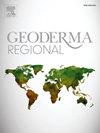Land use effect on soil quality and its implication to soil carbon storage in Aleta Chuko, Ethiopia
IF 3.3
2区 农林科学
Q2 SOIL SCIENCE
引用次数: 0
Abstract
Soil quality index (SQI) is a useful tool to identify soil productivity status and design management strategies. Land use (LU) and management conditions can affect the physico-chemical qualities of the soil which in turn influences the carbon storage ability of the soil. However, the effects of LU on soil quality and associated carbon storage are not well understood in the Aleta Chuko. Three transect lines were drawn based on spatial analogue design covering three LU types, 4 plots for each land use from individual transect, 12 plots per LU, a total of 36 plots, and then 108 soil samples (0–30 cm depth) were taken in three diagonal pits within 20 × 20 m. 19 soil physico-chemical and biological properties were evaluated for SQI, and 12 soil quality indicators were selected using principal component analysis. The results showed that soil physico-chemical and biological characteristics were better under Coffee-enset based agroforestry (CEA) than Chat mono-cropping (CM) and Eucalyptus woodlot (EW). CEA showed significantly higher macro aggregate ≥ 5 mm, steady infiltration rate, Av. P, Av. K, Ex. K, total N, CEC and MBC, but no significant difference was observed between CM and EW in these variables (p < 0.05). SQI of CEA, CM and EW were 0.61, 0.53 and 0.50, respectively. The higher SQI in CEA was due to high MBC(586.3 μg g−1 soil), litterfall, SOM (4.7 %) and low bulk density (BD, 0.87 g cm−3). Total soil organic carbon was significantly higher in CEA (35.2) > CM (24.2) > EW (19.4) g kg−1 soil and the same is true for Mg2+ CEA (4.9), CM (3.9) and EW (2.7) meq 100 g−1 (p < 0.05). Multiple regression analysis on five (BD, CEC, MBC, Ex. Ca and macro aggregates) soil quality determinant variables predicting SOC showed that these variables have a significant effect on SOC (p < 0.001). Specifically, BD and MBC were significant negatively and positively predicting variables of SOC, respectively (p < 0.001). This study suggests that LU practice and management variances over similar biophysical environments resulted in variations in soil physico-chemical, biological properties and the subsequent difference in SQI which in turn determine SOC storage capacity of the soil. Long-term effects of Eucalyptus and CM on soils should be a concern for degradation, although their short-term economic benefits are attractive.
埃塞俄比亚Aleta Chuko土地利用对土壤质量的影响及其对土壤碳储量的影响
土壤质量指数(SQI)是识别土壤生产力状况和制定管理策略的有效工具。土地利用和管理条件会影响土壤的理化性质,进而影响土壤的碳储存能力。然而,在Aleta chuuko, LU对土壤质量和相关碳储量的影响尚不清楚。采用空间模拟设计,绘制3个样条线,覆盖3种土地利用类型,每个样条线4个样条线,每个样条线12个样条线,共36个样条线,在20 × 20 m范围内的3个对角坑中采集108个土壤样品(深度0 ~ 30 cm),利用主成分分析法评价19个土壤理化生物学性状,选取12个土壤质量指标。结果表明,以咖啡为基础的农林业(CEA)土壤理化和生物学特性优于单作(CM)和桉树林地(EW)。CEA的宏观团聚体≥5 mm、稳定入渗速率、有机磷、有机钾、速效钾、全氮、CEC和MBC显著高于CM和EW,但CM和EW在这些变量上无显著差异(P和lt;0.05)。CEA、CM和EW的SQI分别为0.61、0.53和0.50。东部地区SQI较高的原因是土壤MBC(586.3 g g−1)、凋落物、SOM(4.7%)和容重(0.87 g cm−3)较低。东部地区土壤总有机碳显著高于东部地区(35.2);CM (24.2) >;EW (19.4) g kg−1土壤,Mg2+ CEA (4.9), CM(3.9)和EW (2.7) meq 100 g−1土壤也是如此(p <;0.05)。预测土壤有机碳的5个土壤质量决定变量(BD、CEC、MBC、Ex. Ca和宏观团聚体)的多元回归分析表明,这些变量对土壤有机碳有显著影响(p <;0.001)。其中,BD和MBC分别为显著的负向和正向预测变量(p <;0.001)。研究结果表明,在相似的生物物理环境下,土壤土壤的土壤理化、生物特性和SQI的差异决定了土壤有机碳的储存容量。桉树和CM对土壤的长期影响应该引起人们的关注,尽管它们的短期经济效益是有吸引力的。
本文章由计算机程序翻译,如有差异,请以英文原文为准。
求助全文
约1分钟内获得全文
求助全文
来源期刊

Geoderma Regional
Agricultural and Biological Sciences-Soil Science
CiteScore
6.10
自引率
7.30%
发文量
122
审稿时长
76 days
期刊介绍:
Global issues require studies and solutions on national and regional levels. Geoderma Regional focuses on studies that increase understanding and advance our scientific knowledge of soils in all regions of the world. The journal embraces every aspect of soil science and welcomes reviews of regional progress.
 求助内容:
求助内容: 应助结果提醒方式:
应助结果提醒方式:


